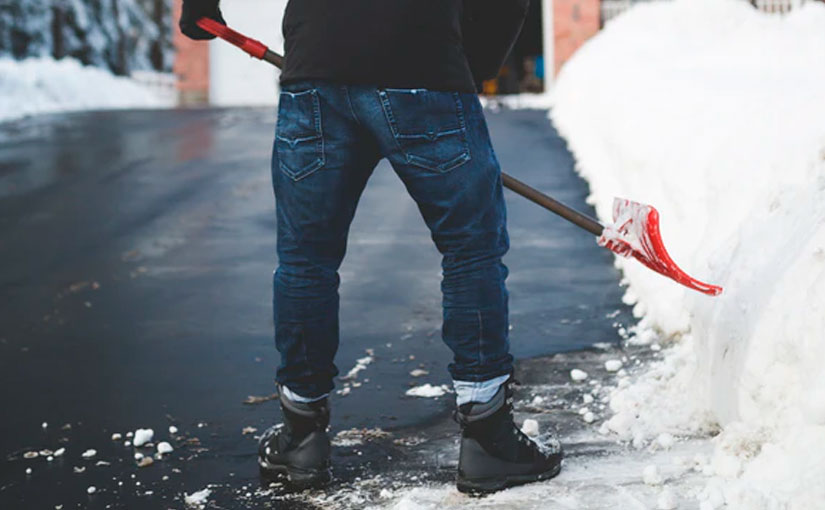Imagine falling after slipping on some ice while you were cleaning snow off your front walkway. You hear the crack, and before you know it, you fractured your ankle or wrist.
These types of accidents can happen when folks go out after a winter storm to shovel their walkways and driveways.
You can prevent getting hurt or suffering from a heart attack by taking precautions before you go outside to shovel snow.
11 Tips for Safe Snow and Ice Removal
An ounce of prevention will keep you from the local urgent care or emergency room. Use these tips to help you avoid a trip to the hospital:
- Check-in with your doctor before you pick up a shovel and go outside. If you have heart problems or are older, you could slip and fall while working outside.
If you need to avoid shoveling snow, hire the local neighborhood kids to shovel your walkways and driveway. You’re doing a community service by supporting a start-up business and getting kids away from their screens.
- Warm-up before heading outdoors. Do some light stretches to warm up your muscles before putting them to work. Also, slowly start if it’s been a while since you performed heavy exercise.
- Dress in layers because it’s cold outside, and you’ll warm up as you shovel snow. Make sure you wear a hat and gloves to keep your body warm and your hands from frostbite.
- Take a bottle of water with you to stay hydrated. You’ll work up a sweat while shoveling snow, and you need to keep hydrated to keep going.
- Invest in a sturdy shovel. While you can buy shovels just about anywhere, you should invest in an ergonomic shovel for shoveling. Buy a shovel with light plastic or aluminum, so it’s not too heavy for pushing snow.
- Use the correct shoveling techniques to avoid twisting your back or falling. Grip the shovel close to the blade or use an ergonomic shovel.
Read more: Time for the Last Mow of the Year + Tips for Winterizing Your Lawn Equipment
Designate a space for snow, then shovel a path down your driveway or on your sidewalk, pushing snow out of the way.
Take small amounts of snow off your walkway and toss the snow to the side rather than picking it up and over your shoulder.
Throwing snow over your shoulder could cause you to strain your lower back and shoulder muscles. You also increase your risk for overexertion that could lead to a heart attack or a fall.
Stop shoveling when you start feeling muscles straining or you’re having any pain in your chest or arms, shortness of breath, or dizziness—these are symptoms of a heart attack. Stop shoveling and call 911 right away.
- Stay alert and avoid icy patches. Black ice camouflages itself in shaded areas. Pour kitty litter on your front steps or stoop if there’s ice near your home’s entrances.
- Protect yourself from overexertion and injuries while shoveling deep snow. Start early in the storm to keep snow from piling up.
If you’d rather stay inside and wait out the snowstorm, you’ll need to take layers of snow off at a time to avoid injuries or a heart attack.
- If you remove snow from your roof, start from the ground if possible. Don’t stand directly under the area where the snow will fall to avoid getting buried in it.
Use care when climbing on your roof to remove snow. Only wear boots that have a grip on the snowy roof or put on boot chains.
Don’t work alone. Instead, have someone spotting for you on the ground, so if you do fall, someone’s available to help you.
Finally, don’t pile snow on one end of your roof because the extra weight will cause damage to your home. Instead, rake the snow off the roof onto the ground.
Watch Brinly’s Push Spreader in Action
- Remove icicles and ice around your house. Icicles can become very sharp and long. Protect your kids from injury by removing all icicles.
If your walkways or driveway is icy, use magnesium chloride to melt the snow. Calcium chloride causes damage to many surfaces, and it’s hard on your pets’ feet.
- Use precautions when using your snowblower too. Start with the user manual to understand how your snowblower works. Add fuel to your snowblower before heading out to blow snow, and don’t use your hands or feet to clear snow away from the blower.
Invest in a Brinly Spreader to Melt Ice Away from Your Walkways and Driveway
While the snow is pretty to look at, it can be dangerous. Of course, icy areas make winter storms almost intolerable. Reduce your risk of falling on the ice this winter by investing in a Brinly spreader.
Our tow spreaders work year-round, including the winter, by spreading sand or salt on your driveway to keep ice from forming. Our push spreaders will spread ice melt or sand on your walkways to keep you and everyone else safe from falling on ice.
Each spreader in our line-up is built with easy calibration settings, a fully enclosed gearbox, and stainless steel hardware to prevent corrosion and downtime.
Find your next Brinly spreader online. If you can’t find any Brinly attachments near you, contact our customer service at 877-728-8224 or fill out our contact form.
Sources:
AmFam.com, “Tips for Snow Removal Safety.”
HeatTrak.com, “The Most Common Snow Shoveling Injuries.”
HomeDepot.com, “How to Shovel Snow.”
LovetoKnow.com, “Snow Removal Safety Tips.”


